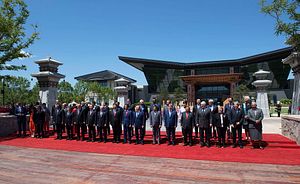Trans-Pacific View author Mercy Kuo regularly engages subject-matter experts, policy practitioners, and strategic thinkers across the globe for their diverse insights into U.S. Asia policy. This conversation with Dr. Tamara Chin – Associate Professor of Comparative Literature at Brown University and author of Savage Exchange: Han Imperialism, Chinese Literary Style, and the Economic Imagination (Harvard, 2014) – is the 93rd in “The Trans-Pacific View Insight Series.”
What is Beijing’s message behind the historic and contemporary symbolism of the “One Belt, One Road” (OBOR) Initiative?
OBOR is a map with a mission. OBOR’s map of overland and maritime connections spanning Asia, Europe, and Africa encodes a new panoramic infrastructure of railways, shipping routes, financial mechanisms, and political agreements to facilitate “unimpeded trade” and information exchange. Rhetorically, OBOR is a palimpsest of past and future. As a “Silk Road” map, OBOR envisions an interconnected Afro-Eurasian future grounded in an interconnected Afro-Eurasian past. It seeks to tell us that OBOR is not spanking new; that connection is reconnection; that before globalization we already had a proto-globalized Silk Road world. OBOR’s new order thus represents itself not as a challenge (to, say, U.S. hegemony), but as a renewal of an older order.
How does this compare to the trade routes and reach of ancient Greece and Rome?
There was no direct trade and diplomacy between Greece, Rome, and Han China. Indeed some recent scholarship has argued that the traffic in ideas, languages, culture, and technology was more important to first millennium Eurasian exchange than actual commerce. That said, scholars have tracked biographies of things that were traded, gifted, stolen, or repurposed amongst diverse communities across the continent (e.g., Chinese paper, Roman glass). Archaeologists continue to show how much older and more extensive these Silk Road networks were than previously imagined. In reconstructing medieval travel, we now draw on manuscripts and inscriptions found across China in Sanskrit, Arabic, Persian, Sogdian, Syriac, and Hebrew.
Compare the Chinese-led Belt Road Initiative and the ancient Silk Road.
The Silk Road belongs to modern diplomacy as much as history.
The modern term “Silk Road” has always been tied to geo-economic initiatives. The German geographer Ferdinand von Richthofen coined the term “Silk Road” in 1877 on a map of ancient Han dynasty trade routes that he used to propose a new China-to-Europe railroad. In launching OBOR in 2013, and again in mid-May this year, Xi Jinping invoked these same ancient routes as a precedent for a modern Afro-Eurasian Silk Road linked by industry, information technology, as well as railroads.
Within academia, the Silk Road also remains an imprecise term, whose history is still being written. The phrase “maritime Silk Road” only emerged in the 1980s. Since the ancients themselves had no term for the Silk Road, scholars as much as politicians take license in its definition.
Ultimately, OBOR’s relation to the diplomatic idea matters more than its relation to the empirical past. OBOR is but one in a series of recent Silk Road initiatives for which the idea of renewing a shared interconnected past is rhetorically useful — recall the Bush-era 1999 “Silk Road Strategy Act” for U.S. policy in Central Asia and the Caucasus.
In what ways is OBOR similar to these earlier “Silk Road” initiatives?
China’s “Silk Road” diplomacy began during the Cold War, with Foreign Minister Zhou Enlai’s non-aligned diplomacy with the decolonized world. After the First Afro-Asian Conference in Bandung, Indonesia in 1955, state newspapers presented China’s establishment of political and economic ties with Arab, Asian, and African nations not as the inauguration of a brave new world, but as the renewal of ancient overland and maritime relations that had been interrupted by European colonialism. Diplomats reserved the term Silk Road for relations with Afghanistan, Pakistan, Syria, and later Iran and Turkey. However, the rhetorical trope of colonial disruption and postcolonial restoration of ancient commerce pervaded Afro-Asian diplomacy and was echoed in the newspapers of some partner states (e.g., Pakistan, Somalia). This anti-colonial model of the Silk Road disappeared after Nixon’s visit to China in 1972, when China adopted the West’s version of the Silk Road as a symbol of East-West harmony.
Explain the diplomatic relevance of OBOR.
Today’s diplomatic rhetoric of reviving an interconnected past through industrial projects thus already circulated a generation ago. For many in China and abroad, OBOR is recirculating, rather than inventing narratives of shared Han and Ming dynasty Silk Road ancestors. With OBOR, as under Zhou Enlai’s non-aligned diplomacy, there is a heavy weighting toward using Chinese classical texts, Chinese artifacts, and Chinese travelers to represent the Silk Road and its narrative origins.

































